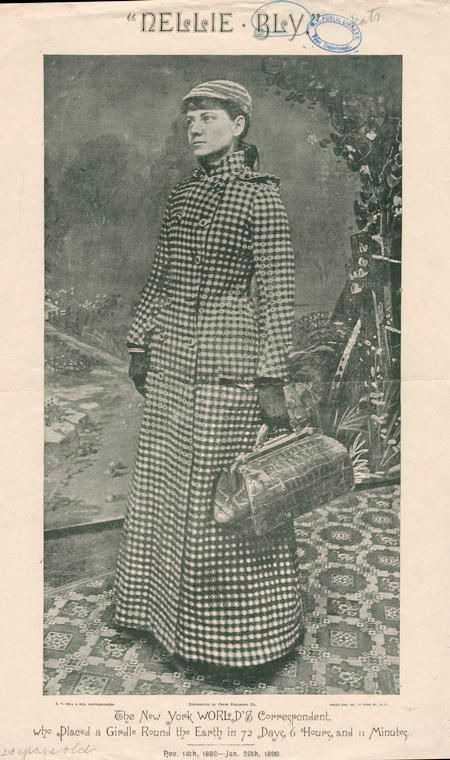VR Experience Lets You Join Nellie Bly on Her 72-Day Trip Around the World
The Newseum, Vive collaboration catalogues the intrepid reporter’s record-breaking journey
/https://tf-cmsv2-smithsonianmag-media.s3.amazonaws.com/filer/05/a8/05a85bf8-e03b-432a-81f6-fa73fa2461b5/w768q92.jpeg)
Nellie Bly famously circumnavigated the globe in 72 days, besting the 80 days it took Phileas Fogg to complete the same task in Jules Verne’s popular novel and sending readers flocking en masse to the pages of Joseph Pulitzer’s New York World, where the journalist catalogued her dispatches from around the world.
Pulitzer almost sent a male reporter on the journey, but Bly issued a prescient warning, declaring, “Start the man, and I'll start the same day for some other newspaper and beat him."
Now, a new virtual reality experience by Vive Studios, the Newseum and Immersion makes it possible for aspiring journalists and world travelers alike to get a better sense of the pioneering reporter’s record-breaking adventure.
“Nellie Bly: The Virtual Reality Experience” tracks Bly’s travels from Egypt to Sri Lanka, Hong Kong, San Francisco and beyond, charting the events the intrepid journalist faced along the way, including a surprise snowstorm that threatened to slow her progress, a stop in Singapore where she bought a pet monkey, and the discovery that another woman reporter—Elizabeth Bisland of Cosmopolitan magazine—was close on her heels.
According to the project page, the immersive experience places Bly’s race in historical context, providing users with background on the journalist’s previous reporting accomplishments, as well as related milestones in the women’s rights movement.
“Nellie Bly” is far from the Newseum’s first foray into either the stunt reporter's life or the ever-growing field of virtual reality. As Vive notes in a blog post detailing the project, the Washington, D.C.-based museum has previously partnered with Vive to create VR explorations of the Unabomber investigation and the Berlin Wall.
Bly herself is a central character in the Newseum’s one-time 4-D introductory film (now playing only in 2-D), which recounts the undercover operation that skyrocketed her to fame just two years before her around-the-world journey, as well as similar journalistic exploits by the likes of radio and broadcast giant Edward R. Murrow.

Born Elizabeth Jane Cochrane in May 1864, Bly began her career writing what PBS NewsHour’s Howard Markel refers to as “women’s columns,” which focused on domestic topics such as gardening and childrearing. Eager to tackle harder-hitting assignments, she agreed to feign madness and have herself committed to one of New York’s insane asylums. Once inside the notorious Blackwell's Island asylum, she catalogued the dire conditions faced by female inmates, recording abusive treatments ranging from mandatory cold baths to solitary confinement in vermin-filled rooms. Upon her release in October 1887, Bly wrote a six-part exposé—later entitled Ten Days in a Mad-House—for the New York World and became an instant sensation.
Soon, so-called stunt reporters inspired by Bly’s work were popping up across the United States and Britain: As Kim Todd notes for Smithsonian magazine, these journalists “went undercover and into danger to reveal institutional urban ills, … [offering] a vision of womanhood that hadn’t appeared in newspapers before—brave and charming, fiercely independent, professional and ambitious, yet unabashedly female.”
Bly’s globetrotting adventure was designed less to expose societal wrongdoing than provide a singular stunt for the World’s eager audience, but much like her earlier investigative stint, it proved to be an unparalleled success. Writing for Mental Floss, Roma Panganiban details the highs and lows of the journey: During the initial transatlantic crossing to London, for example, Bly became violently seasick and rested in her cabin for so long that the captain eventually knocked on her cabin door, fearful he would find a corpse lying inside. As a single woman traveling alone, Bly also attracted men’s unwanted advances, even receiving a marriage proposal from a man who believed her to be an eccentric American heiress.
After arriving in London, Bly traveled to Paris by train, making a short pit stop in Amiens to meet the man who had inspired her trip: Jules Verne. According to Marissa Fessenden of Smithsonian.com, Verne reportedly told her, “If you do it in seventy-nine days, I shall applaud with both hands.”
The biggest surprise of the trip came when Bly was arranging her sea journey from Hong Kong to Japan. Told that she was going to lose the race around the world, she replied with a poetically abstract answer, noting, “I am running a race with Time.” Understandably confused, the steamship official retorted, “Time? I don’t think that’s her name.”
The “her” referred to was Elizabeth Bisland, a reporter commissioned by Cosmopolitan to follow Bly and, if possible, beat her to the finish line. Initially, Bisland was reluctant to undertake such a long trip: As Matthew Goodman explains for the Public Domain Review, she told her editor that she was expecting guests for dinner the next day. In actuality, Bisland later admitted, it was the notoriety associated with such an adventure to which she “most earnestly objected.”
Bly arrived in Jersey City on January 25, 1890—exactly 72 days, six hours, 11 minutes and 14 seconds after she had first set out. Not only did she beat Verne’s fictional protagonist, but she also beat her own stated goal of 75 days. Bisland arrived four days later, clocking in at a total of 76 days.
Just a few months after the race, an eccentric Bostonian named George Francis Train shattered Bly’s record, crossing the globe in 67 days, 12 hours and two minutes. And in 1913, a reporter for the New York Evening Sun, one John Henry Mears, made the trip in 35 days, 21 hours and 35 minutes. But it’s Bly’s name that remains cemented in the public imagination as the country’s first female investigative reporter—a phenomenon exemplified by the fact that we are not only reading about her, but virtually stepping into her shoes, to this day.
/https://tf-cmsv2-smithsonianmag-media.s3.amazonaws.com/accounts/headshot/mellon.png)
/https://tf-cmsv2-smithsonianmag-media.s3.amazonaws.com/accounts/headshot/mellon.png)